Gumroad vs. Payhip (+ dealbreakers) – decide in 7 minutes

If you’re looking for a simple way to sell digital products online, you need to make a difficult choice — pick one among hundreds of eCommerce solutions like Payhip and Gumroad.
The truth is, both Gumroad and Payhip are pretty similar (in a way), so we’re not going to waste your time by comparing all of the features one by one. Instead, we’ll try to show the key differences and main dealbreakers that will help you shape your final decision.
So, which platform is right for you? Let’s decide together.
Quick breakdown: Gumroad vs. Payhip
Both Gumroad and Payhip are platforms for selling digital downloads (mostly), but there are still some critical differences between them.
For one, Payhip offers a wider range of built-in features including a course builder, product variants, marketing tools, an affiliate program, and more advanced customization. Gumroad, on the other hand, is a bit easier to use since it’s mainly a solution that allows creators to accept payments online. Plus, even though Gumorad doesn’t have as many built-in features, it offers one that Payhip doesn’t have — email marketing.
That being said, Payhip does have one key advantage over Gumroad: slightly lower fees. With Payhip, you’ll have to pay a 5% transaction fee, whereas Gumroad charges a 10% fee on all sales.
Going on, we’ll take a closer look at Gumroad and Payhip, covering only the potentially deal-breaking similarities and differences of each platform. We’re also going to include a third platform for comparison — Sellfy. Just so you can clearly see how Gumroad and Payhip not only compare to each other, but to other options in the market.
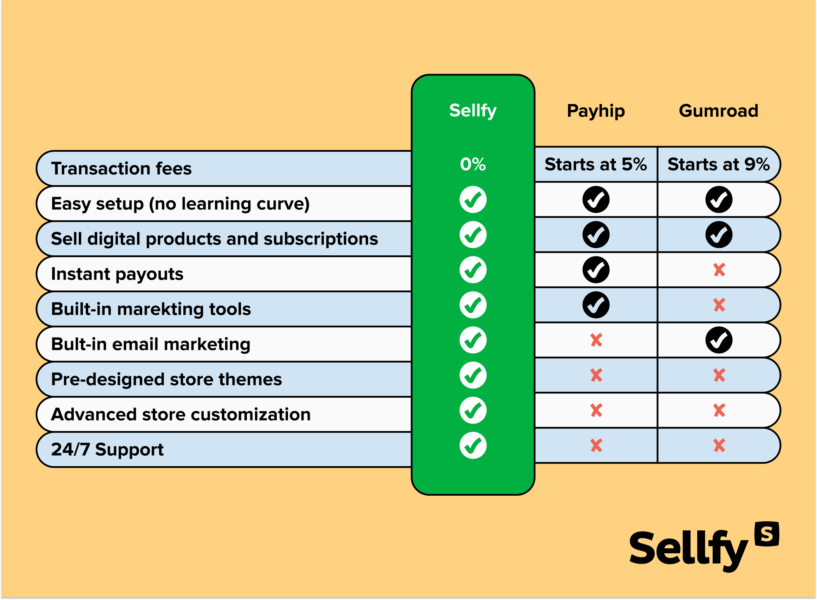
Gumroad and Payhip are similar (in a way)
Both Payhip and Gumroad were built with beginners in mind. It means that simplicity and ease of use are their main focus.
Yes, they both offer a couple of essential eCommerce tools like coupon codes, freebies, and product variants. However, the bottom line is, that both platforms allow you to build a basic checkout page for your digital products or embed one into an existing website.
Now, you might think:
So if both platforms are so similar, I can just choose either one.
Not so fast! While both platforms serve a similar purpose, there are still some things worth considering.
Why would you choose Gumroad over Payhip?
Sure, we love Gumroad for its nearly non-existent learning curve and ease of use.
But, we’ve compiled some real reasons for you to consider choosing Gumroad over Payhip.
1. You can run email campaigns
Even though social media is considered to be a driving force of the creator’s economy, email marketing is still one of the crucial sales and marketing tools for creators and online entrepreneurs.
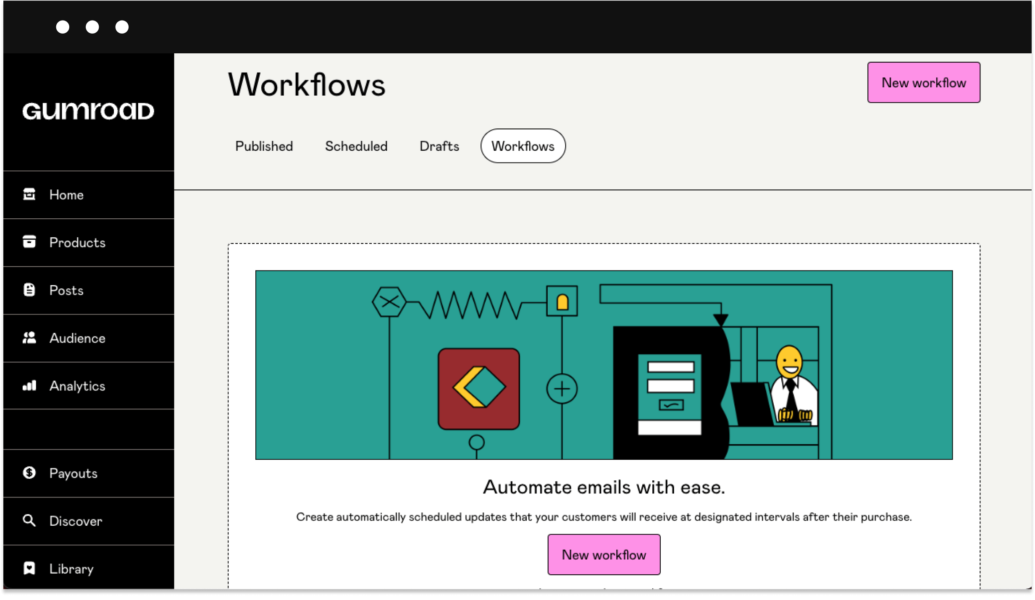
Unlike Payhip, Gumroad offers a free built-in marketing tool that allows you to create an email list or import an existing one. While Gumroad’s email tool has pretty limited functionality, its main purpose is to help you get more sales by:
- Offering freebies
- Announcing product launches
- Sending out newsletters
- Sharing coupon codes
- Creating automated email sequences
You don’t have to sell anything to use Gumroad’s email feature as it’s free to use.
2. It virtually takes minutes to set up a store
Sure, both Payhip and Gumroad are simple enough that almost anyone could figure them out.
However, if we compare both solutions side by side, the clear winner would be Gumroad. Its interface is built to be as simple and understandable as possible.
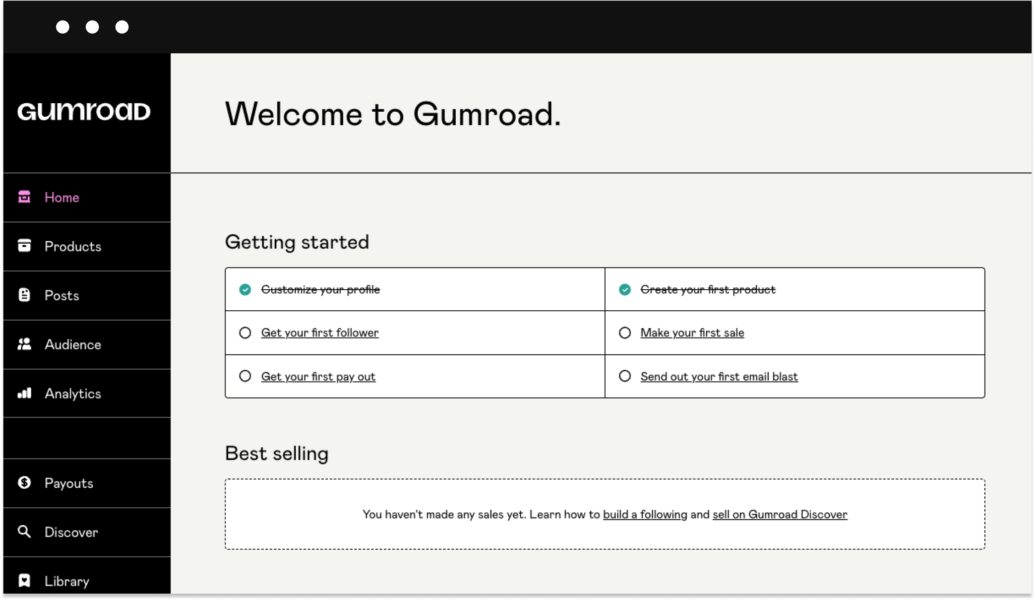
So, if you’re looking for a way to sell subscriptions or digital downloads right this second — Gumroad is your guy. But, be ready that such simplicity comes at a cost. And by cost, I mean not only extreme transaction fees but also a lack of features and limited integration possibilities.
3. Gumroad can recommend your products to potential customers
Of course, we can’t compare Payhip to Gumroad without mentioning one of Gumroad’s coolest features — Gumroad Discover.

Simply speaking, Gumroad Discover will recommend your products to people browsing the Gumroad Discover marketplace. You may consider this as another marketing tool for your product.
Not for free, of course.
They’ll take an extra 10% of each transaction for featuring you on the Gumroad Discover platform. But still, Payhip doesn’t offer anything like that at all.
The main disadvantage of Gumroad
I know, Gumroad seems like a great tool for selling digital products, but there are some things you should know before you sign up.
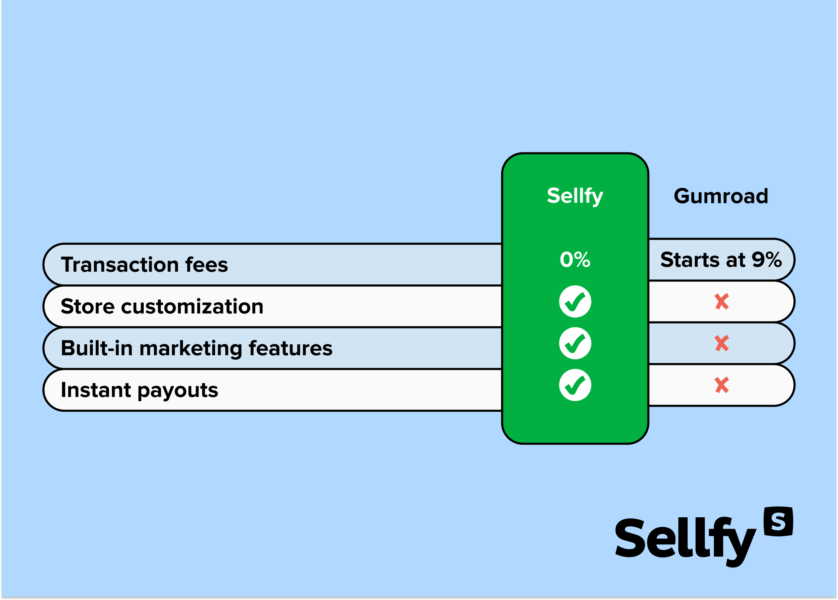
Let’s talk about some of them in more detail.
1. Extreme transaction fees
Gumroad doesn’t have a subscription fee, but it doesn’t mean that you can use it for free.
Let me explain:
When you first start selling, Gumroad takes a crazy 10% commission +30¢ fee for each transaction. This means that if you’re selling a $100 product, Gumroad will keep $9 from each sale. So, if you make five sales a month, you can say goodbye to as much as $45.
Knowing that, can we say that Gumroad is free to use? We’ll leave it for you to decide.
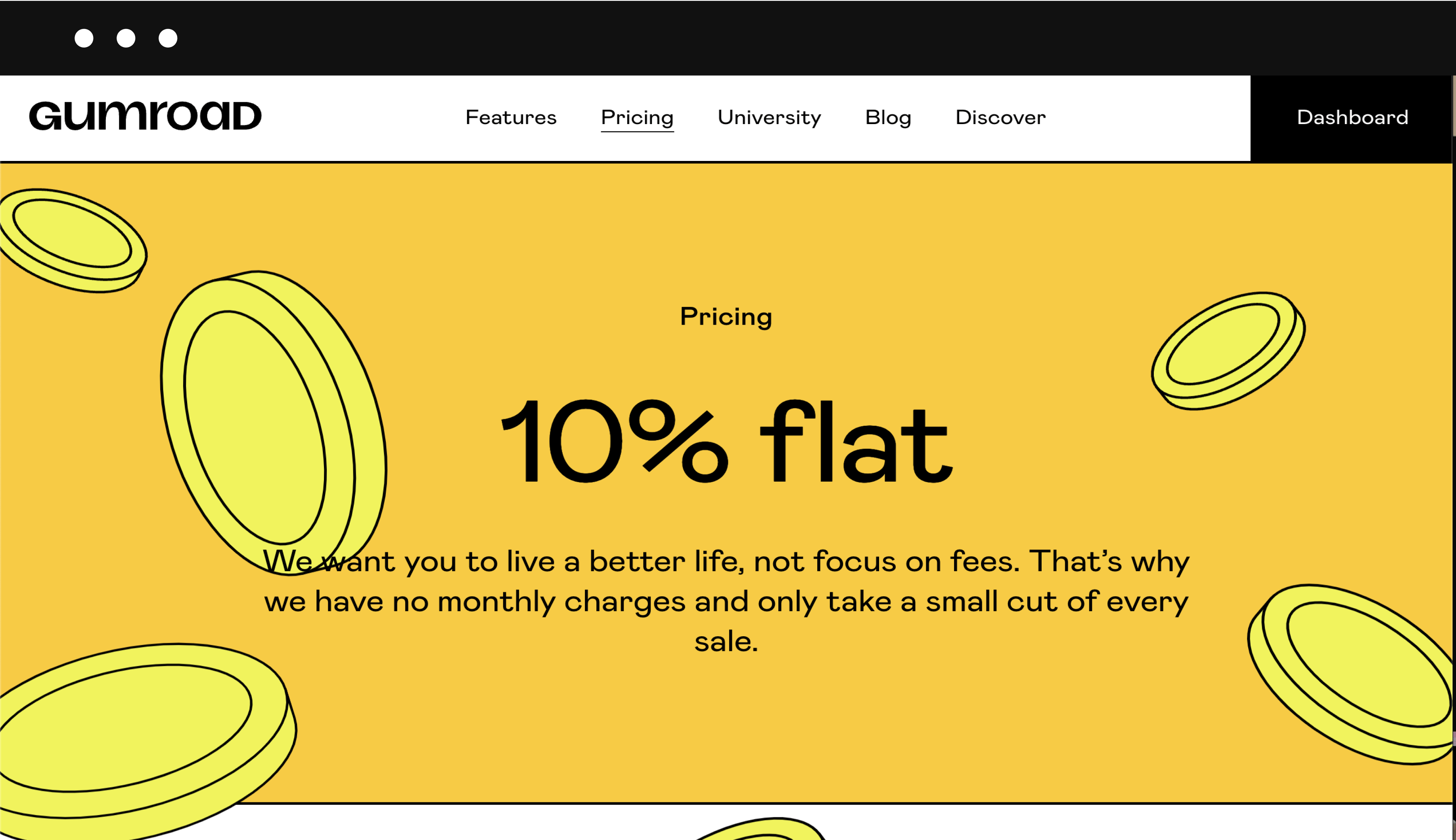
2. You can’t really customize your store
To be honest, it’s not that there’s a lack of customization possibilities — you can hardly customize anything.
There are no store themes to choose from, which means that your page won’t be different from hundreds of other checkout pages powered by Gumroad. You can add some custom fields to the checkout form, customize the virtual receipt, add a custom domain, create product categories, and change some colors — that’s about it.
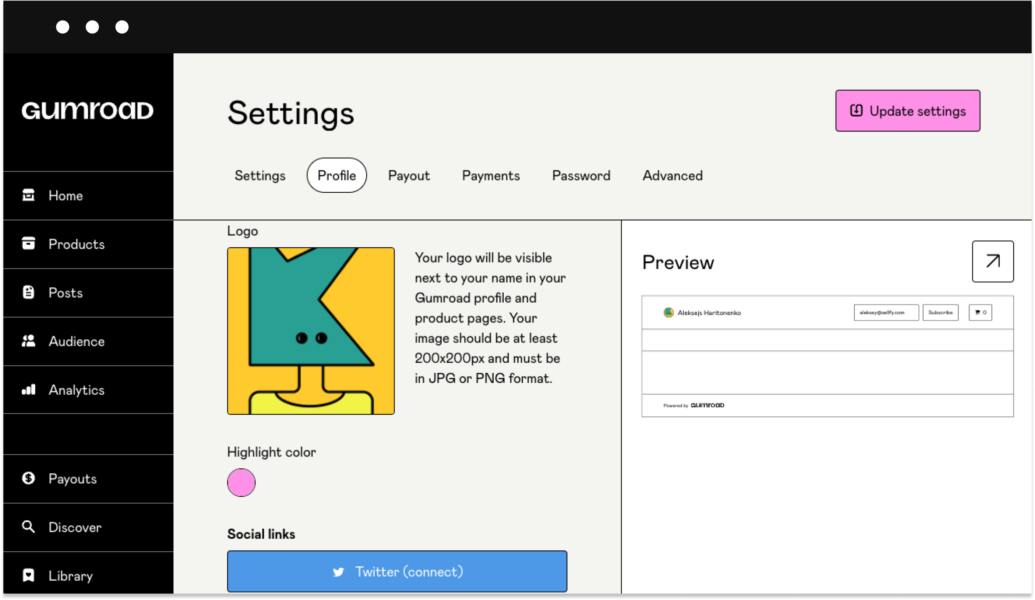
Any advanced customization of your Gumroad store will require CSS skills.
3. There are (almost) no built-in marketing features
Yes, Gumroad allows you to build an email list and issue discount codes — but that’s where the list ends.
Unlike Payhip, Gumroad doesn’t offer other promotional tools. It means that you won’t be able to make bump offers, upsell or cross-sell your digital products, or send cart abandonment emails.
4. No more PayPal payouts.
Just as creators were getting used to Gumroad’s 10% transaction fee, the platform’s PayPal issue landed as an even bigger blow. In October 2024, PayPal cut ties with Gumroad, leaving creators without one of the most popular payout options. Now, Gumroad users are limited to bank transfers—which, inconveniently, aren’t even available in every country.
The blow doesn’t stop there. Without PayPal, many creators may see fewer sales, as it’s the payment method most customers prefer. Gumroad will hold pending payouts until creators switch to bank transfers, adding more hassle to what was once a seamless process.
The big question? Reliability. When a major payment provider drops off the platform, it raises concerns about stability. If you’re considering other options, now might be the perfect time to explore them.
5. Customer support is not that supportive
The Gumroad team claims that they’re there to provide you with all kinds of support. If you have questions, their Help Center can address the majority of issues. But, in case you need to contact the support team, they will get back to you within 24 hours.
However, the reviews online say otherwise…
There are some reviews online stating that it usually takes quite some time to get an answer from Gmroad’s support team. Plus, the responses can be unhelpful or in some cases even rude.
Why would you choose Payhip over Gumroad?
Even though Payhip is far from being the only alternative to Gumroad, it’s an option worth considering.
And here’s why:
1. More tools to help you promote your products
When compared to Gumroad, Payhip does a better job of helping sellers to promote their products. Apart from offering discounts and an affiliate program, Payhip also has built-in tools like upselling, referrals, and upgrade discounts.
Again, all tools are built with beginners in mind, but they still look slightly more advanced than the ones offered by Gumroad.
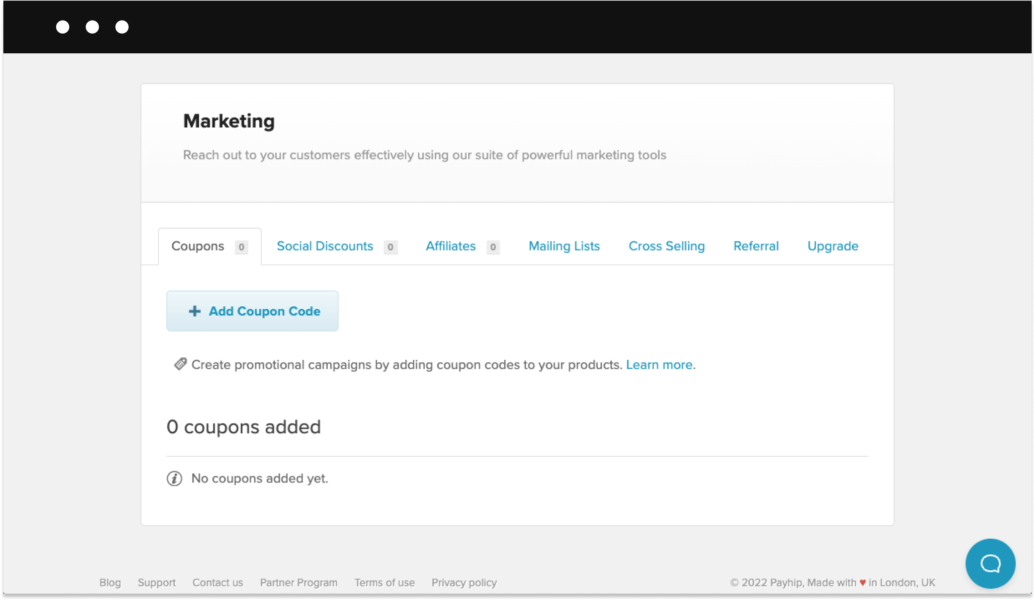
2. Lower transaction fee
Even though Gumroad doesn’t have a paid plan, the fee percentage changes depending on how much money you make.
Payhip has three pricing options. Each of them gives you access to all the same features, the only difference is the transaction fee percentage:
- Free plan with a 5% transaction fee.
- The Plus plan costs $29 a month and has a 2% transaction fee.
- The Pro plan costs $99 a month and has no transaction fee.
3. More ways to customize your store
The truth is that if you want to be able to customize your online store, neither Payhip nor Gumrad is a perfect fit. But between Payhip and Gumroad, Payhip still offers more customization possibilities.
For example, you can add as many sections to your store pages as you need including text blocks, slideshow, and even videos. Apart from that, you can add custom pages, change fonts and colors as well as customize navigation links.

Don’t get me wrong, Payhip’s store customization options are still pretty basic when compared to platforms like Sellfy. But it still beats Gumroad on almost all accounts.
4. You get instant access to your earnings
This one is pretty self-explanatory:
The fact that you get instant access to your earnings not only gives you much more flexibility but also allows you to reinvest your money and grow your online business.
The main disadvantage of Payhip
Even though Payhip looks like a slightly better alternative to Gumroad, it’s still far from being the best eCommerce solution in the market.
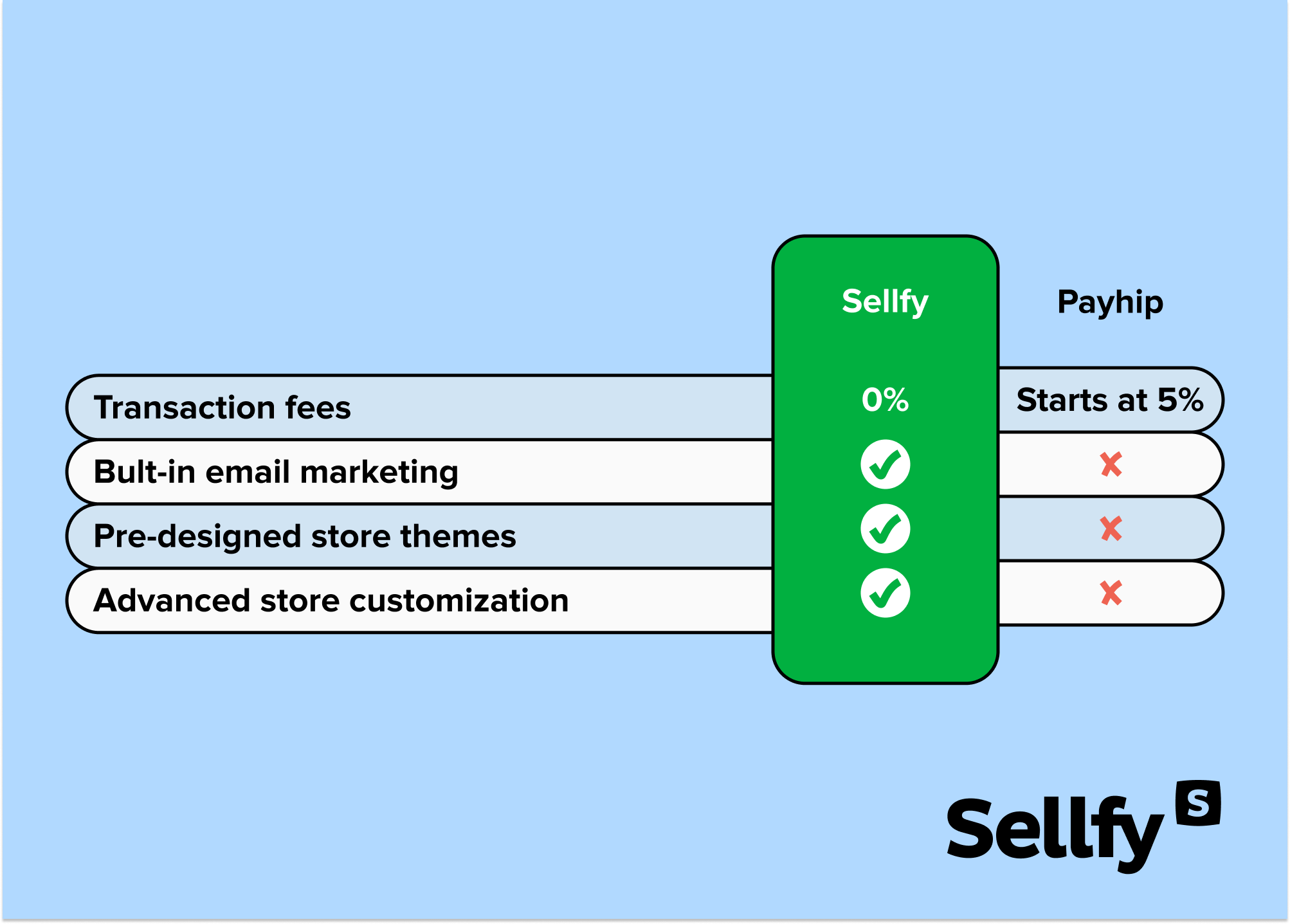
Here are some proofs:
1. You have to pay for an external email marketing service
Without a doubt, Payhip beats Gumroad when it comes to built-in marketing features. But unlike Gumroad, Payhip doesn’t have a built-in email marketing tool. And this could be a major dealbreaker for anyone who’s planning to utilize email as a marketing channel.
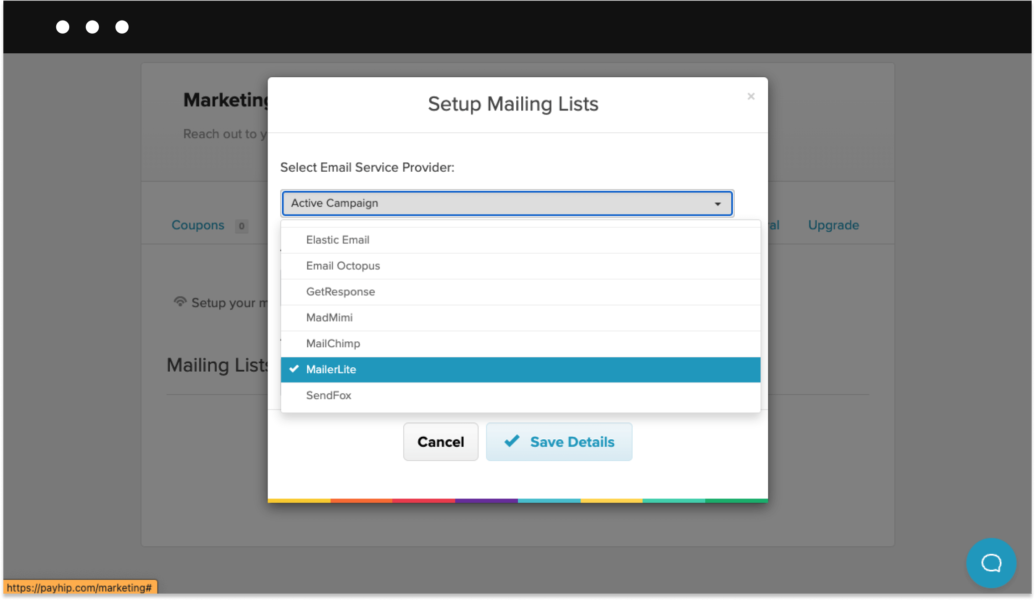
Sure, Payhip integrates with external services like MailChimp, CampaignMonitor, and others, but it doesn’t change the fact that you’ll have to pay for them separately.
2. Transaction fees even on the paid plan
We’ve just talked about how Payhip’s paid plan structure makes more sense.
What doesn’t really make sense is that you still have to pay a 2% transaction fee on top of a $29 monthly fee.
So, in case you’re selling a $100 product, Payhip will still keep $2 from each sale. So, if you make five sales a month, your monthly fee will sum up to $39.

3. Customer support can be hit-and-miss
According to some user reviews online, Payhip’s customer support doesn’t learn from Gumroad’s mistakes.
Some people have reported it’s been quite difficult to get any response from them. Plus, there seems to be a lack of communication in general, even if it’s just an update on what’s going on behind the scenes.
The question isn’t Gumroad vs. Payhip — It’s Why Not Sellfy?
By now, you should have a clear understanding of what both platforms are really capable of. If you’re looking for a more all-in-one solution but almost no built-in features, Gumroad is worth considering. However, if you are in for a slightly more advanced eCommerce toolkit, Payhip could be the better option.
But before you make your final choice, I’d like to make one final case for choosing Sellfy over Gumorad or Payhip:
You get everything you need to promote your products
Let’s face it, both Gumorad and Payhip offer a bare minimum of built-in features. Especially when it comes to marketing tools. Sellfy, on the other hand, has everything you need to launch and grow your online business, including email marketing, discounts & coupon codes, upselling, cart abandonment, and even pay-what-you-want pricing.
You can actually customize your store
Even though Sellfy is incredibly easy to use, it offers a much more advanced store customizer when compare to both Payhip and Gumroad. With Sellfy, you can choose one of the pre-designed store themes or design a completely new store from scratch — no coding, just drag and drop
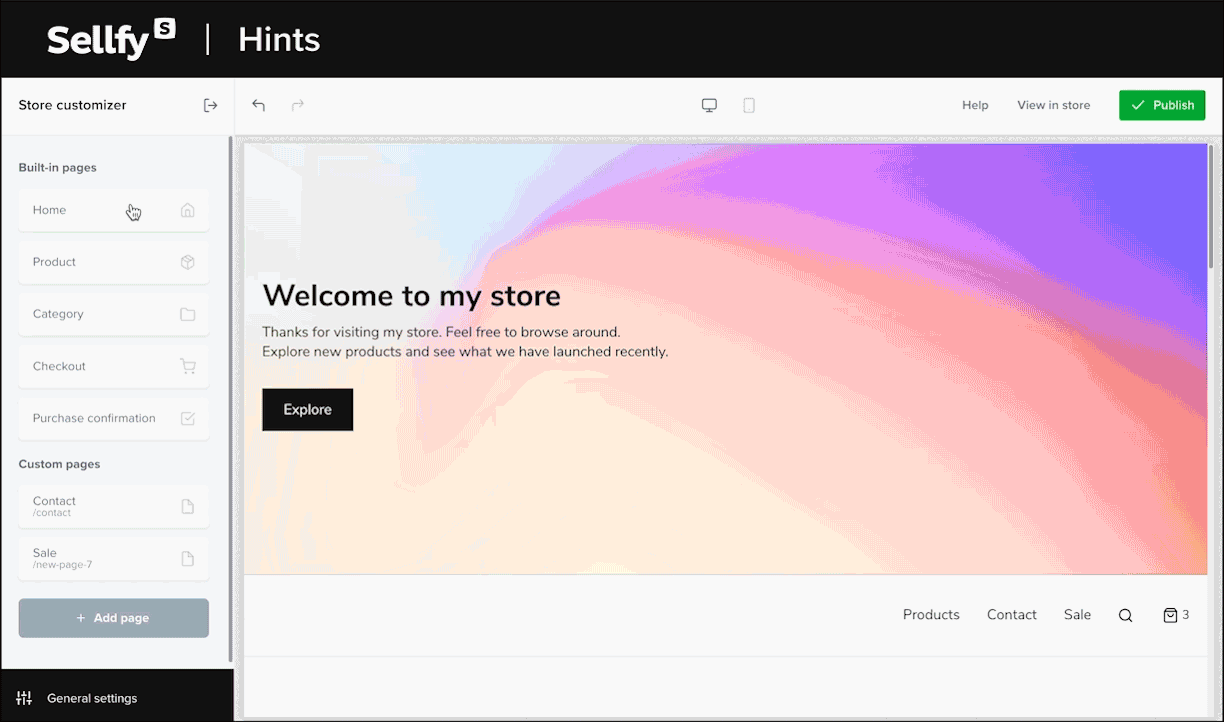
More features but the same effortless setup
With Sellfy, setting up an online store is really a matter of minutes. The best part is that you don’t need any previous experience whatsoever. All you have to do is upload your product, add some description, and name a price.
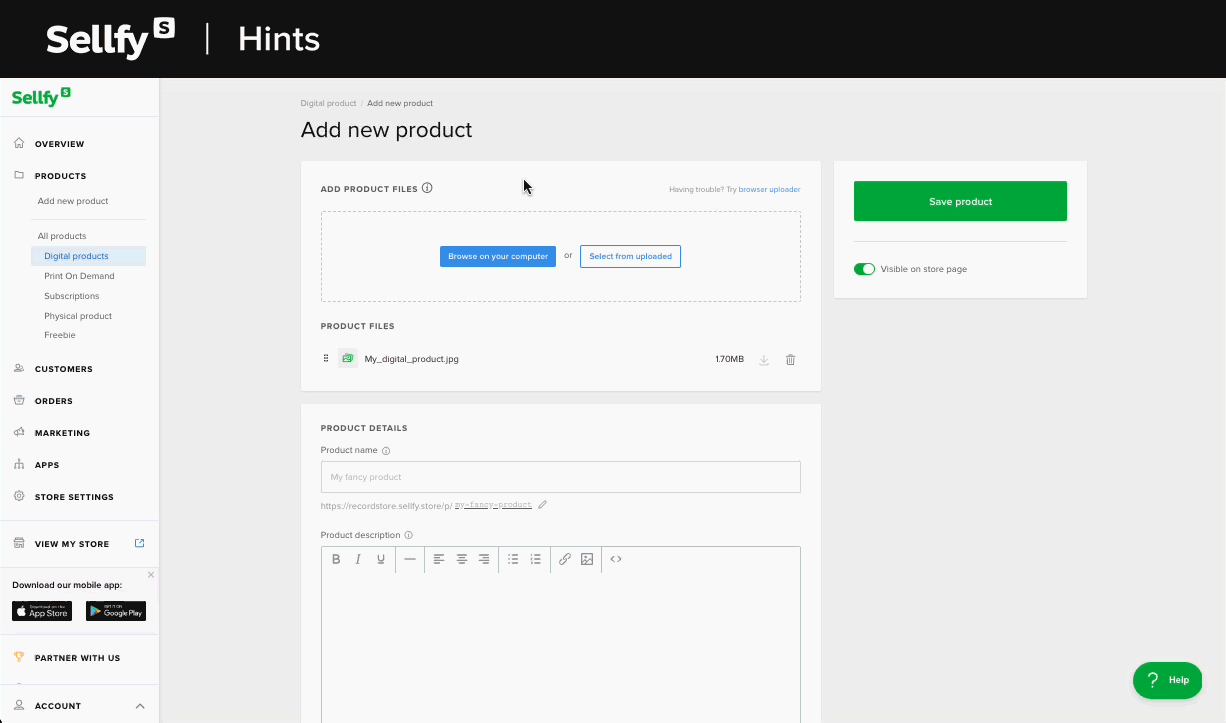
There are no transaction fees on any plans
With Sellfy, you get to sell unlimited products, built-in marketing features, advanced store customization, and even built-in print-on-demand service without transaction fees on all plans.
Fantastic customer support
There’s nothing more important than good customer support when it comes to launching your online store. Sellfy’s customer support team is available 24/7, and it’s really helpful too.
Make sure to check out more Stan Store comparison articles:
FAQ: Gumroad vs. Payhip
What is better than Gumroad?
Sellfy is a powerful platform that enables creators of digital products to sell their work directly to their audience. Unlike Gumroad, Sellfy offers plenty of built-in marketing features, including a print-on-demand service, customizable storefronts, powerful analytics, and seamless payment processing.
Sellfy is also incredibly user-friendly and offers excellent customer support, making it the perfect choice for creators who want to monetize their work.
What percentage does Payhip take?
Similarly to Gumroad, Payhip charges a 5% fee on each sale made through their service, which is deducted from the total amount paid by the customer. This means that creators receive 95% of the sale price for their products.
What’s the difference between Gumroad and Payhip?
Gumroad and Payhip are both eCommerce platforms that allow creators to sell their digital products directly to customers. The main difference between the two is that Gumroad offers more features such as email marketing, analytics, and custom domains, while Payhip is more affordable and has a simpler interface. Ultimately, the choice between Gumroad and Payhip will depend on the specific needs and budget of the creator.




